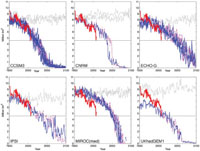
Fig. 1. September sea ice extent as projected by the six models that simulated the mean minimum and seasonality with less than 20% error of the observations. The colored thin line represents each ensemble member from the same model under A1B (blue solid) and A2 (magenta dashed) emission scenarios, and the thick red line is based on HadISST analysis. Grey lines in each panel indicate the time series from the control runs (without anthropogenic forcing) of the same model in any given 150 year period. The horizontal black line shows the ice extent at 4.6 M km2 value, which is the minimum sea ice extent reached in September 2007 according to HadISST analysis. All six models show rapid decline in the ice extent and reach ice-free summer (<1.0 M km2) before the end of 21st century.
Fig. 2. Estimated number of years for sea ice extent to drop from the current value (4.6 M km2) to less than 1.0 M km2 (summer ice free Arctic) based on six models under IPCC emission scenarios A1B (grey) and A2 (white). Each bar represents one ensemble member from each model. The model name is listed on the far-left bar if multiple ensemble members are provided. The far right bars show the model mean (black) and median (hatched) based on all ensemble members combined from both emissions scenarios.
Fig. 3. Mean sea ice thickness for (left) March and (right) September based on ensemble members from six models under A1B emissions scenario. (a and b) Year when the September ice extent reached 4.6 M km2 by these models and (c and d) year when the Arctic reached nearly sea ice conditions (less than 1.0 M km2) in September, i.e., ice free summer.
Return to Abstract
Return to References